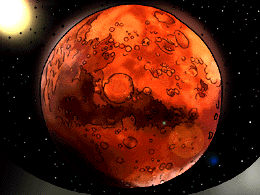


Shortly after Mars was formed, it may have had more atmosphere, more water and more heat - all conditions that would make it more likely to support life. Today, Mars is cooler, has little water, and has a thin atmosphere composed mostly of carbon dioxide. All these conditions are unlikely to support life.
Ever since people have gazed upon the red planet Mars, they have wondered whether life exists on that planet. In 1877 the Italian astronomer, Giovanni Schiaparelli, saw lines on Mars, which people later assumed to be canals built by intelligent beings. It wasn't until the later part of this century that this idea was dismissed. Scientists had several lines of evidence to believe that no life exists on Mars.
One piece of evidence convincing people that Mars has no life came from observing the Martian atmosphere. British scientist James Lovelock found that the Martian atmosphere was not like the atmosphere that would be expected for a planet that was alive. Instead, the atmosphere of Mars is like a planet with no life. A live planet, like Earth, contains gases that react with one another in the atmosphere, like oxygen produced by photosynthesis and methane produced by bacteria. Without constant replenishment from living organisms, these reactive gases would spontaneously combine with one another, forming stable, unreactive gases, like those found in the Martian atmosphere.
![]()
The National Air and Space Administration (NASA) has sent several missions to Mars to investigate whether life exists on Mars. In 1965, Mariner 4 sent back the first close up images of the surface of Mars. These pictures showed Mars to be a dry, lifeless desert, and contributed to the idea that there is no life on Mars. In 1972, Mariner 9 showed dried up water ways on the surface of Mars. Finding these water ways fueled speculation that life may have existed previously on Mars. In 1976 the first spacecraft from Earth landed on Mars. It performed three experiments to search for life on Mars. No life was detected.
![]()
There is a possibility that life may have existed on Mars, but is now extinct.In 1997, NASA landed the Mars Pathfinder on the surface of Mars to search for hints of past life. This explorer landed near a site where life could have existed. This area, called the Ares Vallis, is a site that appears to have been hot and wet at one time. This area may have been like the hot springs of Yellowstone, where microbes flourish today. Perhaps if these ancient microbes existed, some of them may have gotten trapped in minerals and now remain as tiny fossils.
The next time you hear that Mars is in view, go look at it. Can you tell if life ever existed on Mars?